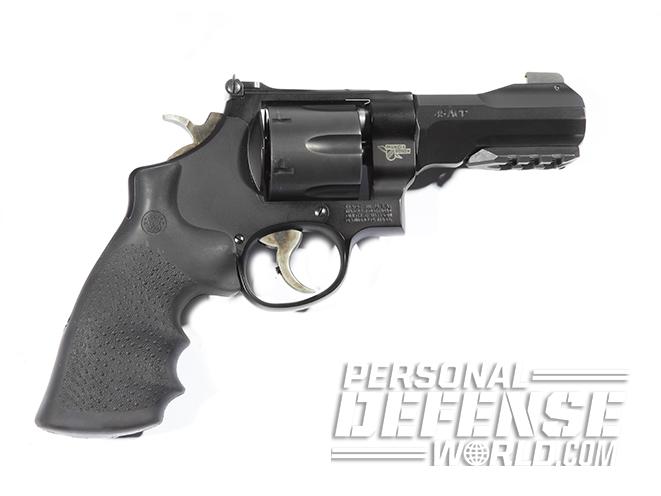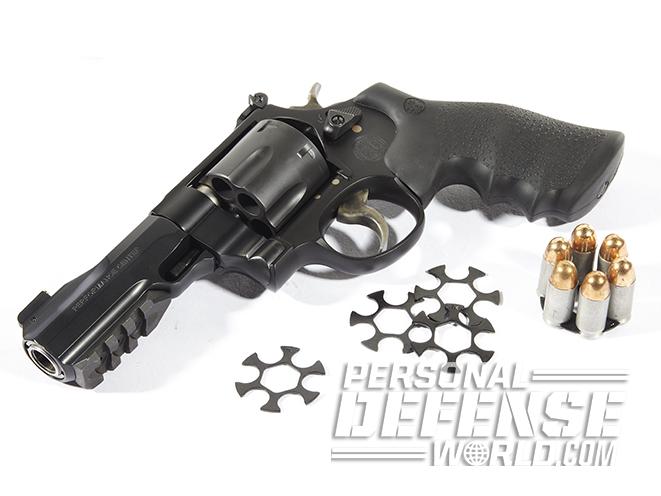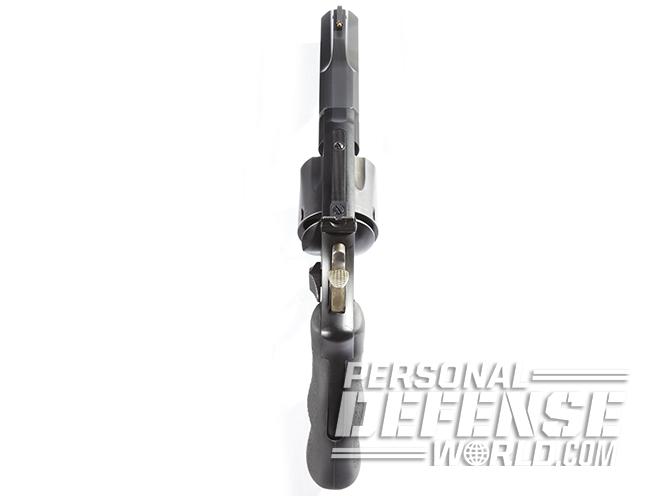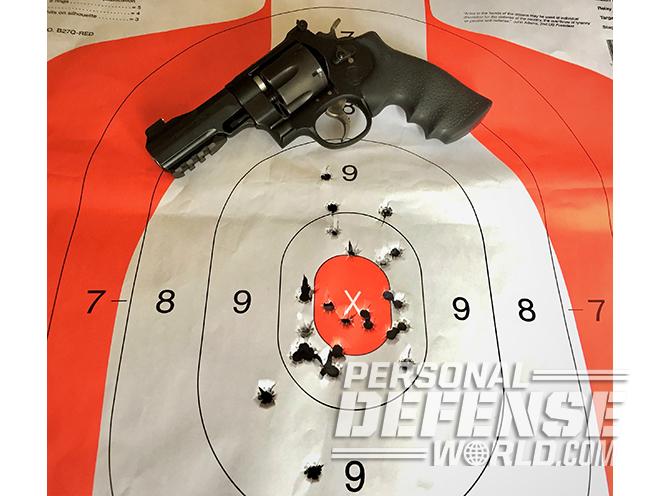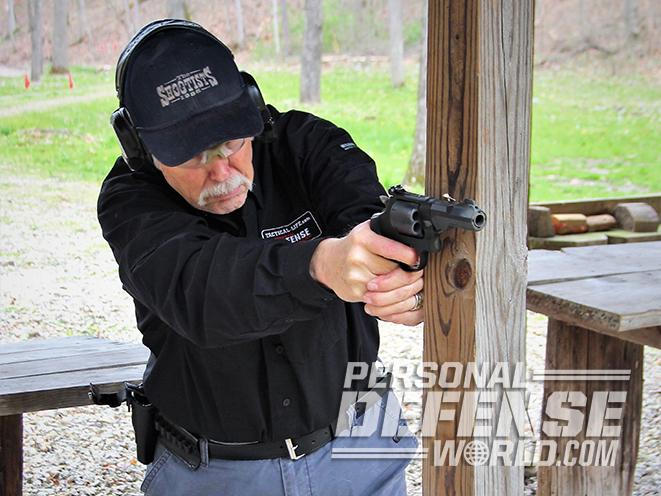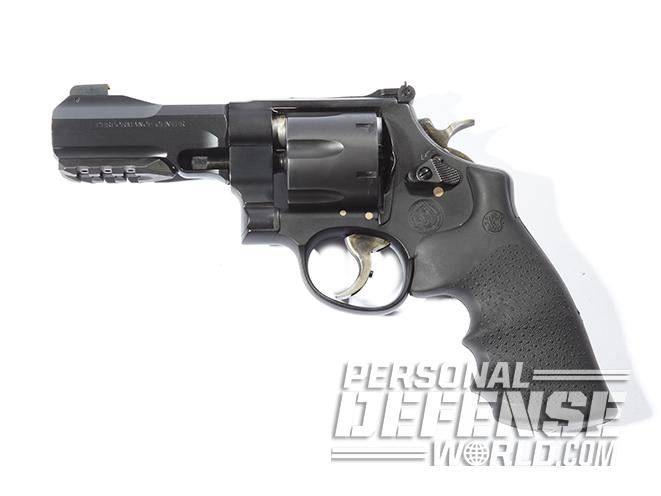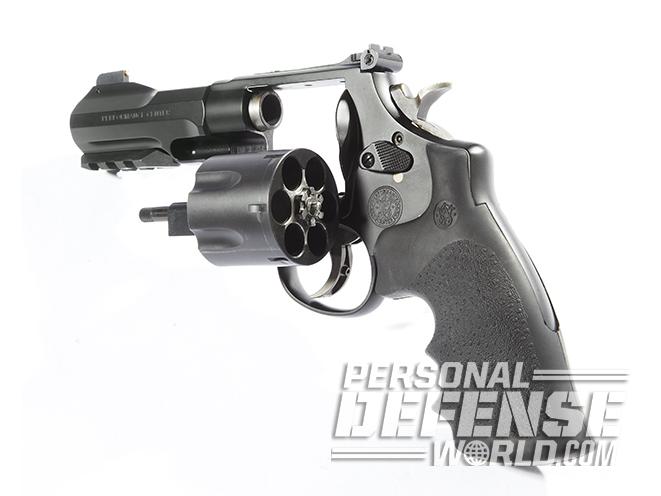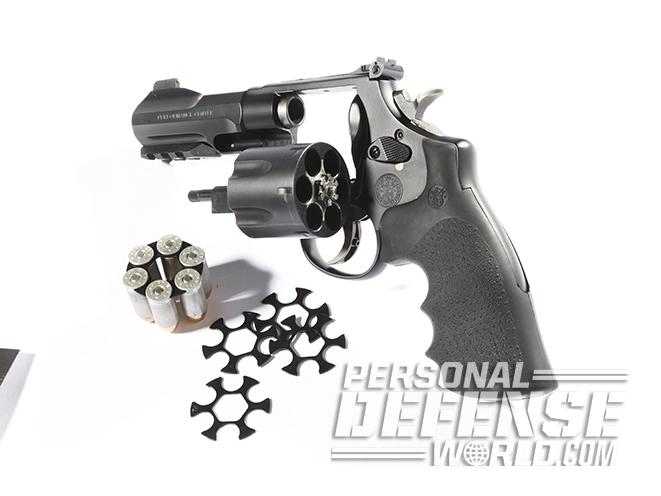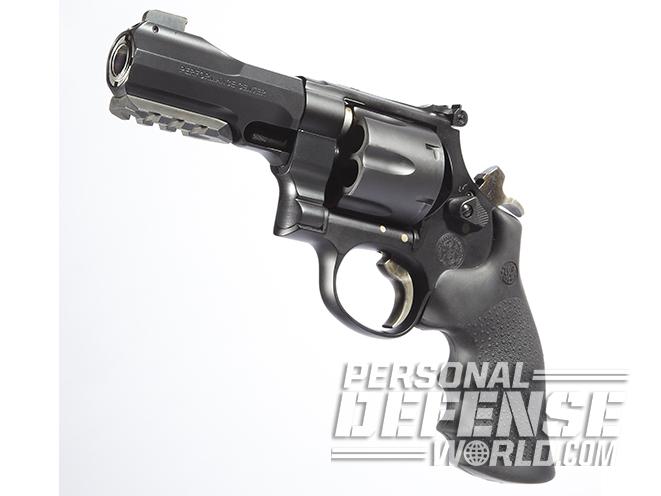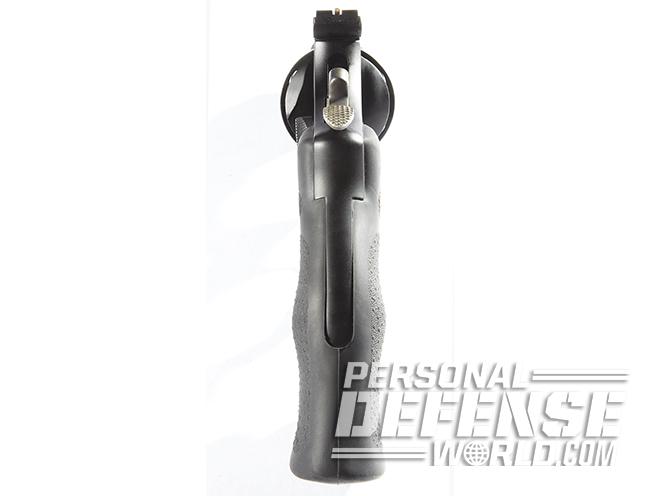I’m a big fan of large Smith & Wesson N-Frame revolvers because they generally chamber big, powerful cartridges. The N-Frame originated with the .44 Special, and it’s been used for every early magnum handgun round. World War I saw the N-Frame chambered for .45 ACP military service ammunition, and this caliber has remained popular over the years in various service and target revolver configurations. One of the latest .45 ACP N-Frames to hit the market is the result of a collaboration between the Smith & Wesson Performance Center and the fertile mind of renowned firearms instructor Clint Smith.
Clint served in the Marine Corps in Vietnam and returned stateside to become a law enforcement officer. He’s also the former dean of instruction at the American Pistol Institute and the founder of Thunder Ranch. Thunder Ranch was designed to showcase new firearms training facilities and equipment while providing expert instruction. Given this wealth of experience, when Clint assists in the design of a firearm, you can bet it will perform as intended.
Built For Fighting
I first saw the Smith & Wesson Performance Center Model 325 at a local gun shop and was immediately struck by its business-like appearance. With the exception of the forcing cone area at the rear of the barrel, the whole thing is a subdued matte black. As mentioned, it’s built on the S&W N-Frame, but the weight is held down to 30.7 ounces because the frame is scandium alloy. The cylinder is stainless steel with the extractor star left “in the white.” The lockwork is steel. The hammer and trigger are color casehardened but still subdued.
Advertisement — Continue Reading Below
The revolver’s trigger has a smooth face and trigger stop while the hammer is a semi-target-style unit with a teardrop-shaped spur that’s been deeply checkered. The S&W Performance Center has tuned the action for a smooth, if not especially light, double-action (DA) pull and a clean 4.15-pound single-action (SA) pull.
More and more, S&W has adopted the two-piece barrel concept for many of its revolvers. An over-barrel shroud encloses the thinner rifled portion of the 4-inch barrel and is secured by a nut that’s flush with the muzzle. Both the shroud and barrel are made of stainless steel. The tension exerted by this arrangement can have a positive effect on accuracy, and the barrel-cylinder gap can be set more precisely. The shroud on the Model 325 looks sort of hexagonal in shape with flats and a sculpted cut that merges into the front sight ramp.
The front sight itself uses a replaceable gold bead. An integral lug also protects the short ejector rod and has a detent for the spring-loaded ball on the front of the cylinder crane, which forms the forward locking point. The bottom of the shroud is drilled and threaded for an accessory rail that is provided with the revolver.
Advertisement — Continue Reading Below
- RELATED STORY: Gun Review – Smith & Wesson Performance Center Model 986
The cylinder crane is made of carbon steel, as is the cylinder release latch. Three pins on which the action operates were left “in the white” to contrast with the matte black finish. Above the cylinder release is a small hole for a key that can lock the hammer. Below the cylinder release is the Performance Center logo, and on the right-front portion of the frame you’ll find a laser- engraved Thunder Ranch logo.
Attached to topstrap is a click-adjustable rear sight. And finally, like many of S&W’s modern wheelguns, the grip frame has the universal round-butt L/N-Frame dimensions, and the Model 325 is provided with a synthetic Hogue Monogrip with pebble texturing on the sides. The grip fit my medium- sized hands very well and provided a secure hold while helping to absorb felt recoil.
My test gun came in a Thunder Ranch Gun Rug made of OD green nylon with a zipper enclosure. Along with the accessory rail, S&W included five moon clips, two keys for the hammer-lock safety, a padlock with a flexible hasp for safe storage, an instruction manual and a DVD titled “The Smith & Wesson Thunder Ranch Defensive Revolver Review & User Guide.” It’s narrated by Clint Smith, and the man knows of what he speaks. I’ve taken a class from him and can tell you that he’s both interesting and engaging. In other words, this DVD is well worth a viewing.
Advertisement — Continue Reading Below
To carry the Model 325, I used an older Askins Style Convertible holster from Uncle Mike’s. While it’s no longer available, this scabbard has belt slots on both sides as well as an adjustable thumb-break retention strap. It fit the Model 325 well, and I paired it with a 0.25-inch-thick, 1.4-inch-wide Versacarry gun belt. To carry the loaded moon clips on my belt, I found a cartridge slide works rather well.
Making Thunder
I chose four different .45 ACP loads from Federal, HPR, Precision Delta and Remington to test the Model 325. These rounds ranged from practice ammo to match-grade fodder. And after obtaining some velocity figures with each load, it was time to measure the revolver’s accuracy.
Due to the revolver’s 4-inch barrel and target sights, I tested it at 25 yards from the bench using a sandbag rest for support. The rear sight took some adjusting, as it came in the lowest possible position, which provided for some very low groups. So, I adjusted its elevation and a little windage, too. Then I fired three 5-shot groups in SA mode using each of the test loads. The tightest cluster, measuring just 1.85 inches, came with the HPR 185-grain JHP ammo. This load also had the best group average at 2.24 inches. Second place went to the Precision Delta 230-grain FMJs at 2.25 inches. These two cartridges also shot close to the point of aim, but I had several light primer strikes with the Precision Delta ammo. This only happened during the chronographing and accuracy testing portions of the evaluation.
Advertisement — Continue Reading Below
This is a Thunder Ranch revolver, which means it’s built for serious defensive purposes. With that in mind, I ran the Model 325 through a U.S. Customs & Border Protection combat qualification course. I donned the gun belt and loaded all five of the moon clips with a mix of the .45 ACP test ammo. I loaded one clip in the gun and kept two clips on my belt using the cartridge loop slide. I put the other loaded moon clips in the left-front pocket of my BDUs.
Shooting commenced at 3 yards, where I drew the handgun and fired “point-shoulder” using only my strong hand against a red B-27Q silhouette. After the final shot, the revolver was reloaded, placed in my support hand and fired until empty, then reloaded again. Once an area threat assessment had been performed, the handgun was worked back into the holster and secured. This final process was used in all of the course stages. There’s no award for getting the gun back into the holster the quickest, and you also need to make sure you keep an eye on the threat area even when you’re reloading and reholstering.
- RELATED STORY: 5 Titans Who Influenced Revolvers, Ammo & Handgun Shooting
Moving back to 7 yards, I drew the Model 325 in an isosceles stance, acquired the sights and fired two rounds at the center-mass of the target. After assessing for threats, I lowered the gun into a low-ready position, then raised it again to fire two more rounds. I repeated this one more time, reloaded, assessed the area for threats and reholstered the gun. From the same distance, I drew the S&W Model 325 revolver and fired two shots center-mass and one to the pelvis in what’s termed a “body armor drill.” I repeated this string of fire before reloading, assessing and reholstering.
Advertisement — Continue Reading Below
Next, I stepped back to the 15-yard barricade. After drawing the handgun, I fired two shots using the sights from the left side of the barricade, two shots from the right side while standing and two shots while kneeling. I reloaded, reassessed and reholstered.
All of my shots stayed within what might be called the “K-zone” of the silhouette target. The two lowest shots were from the body armor drill. A similar drill has two center-mass shots and one to the head, but that is a much smaller and usually moving target, so some recommend the pelvis shot, which may break bone and cause the subject to fall.
Throughout the evaluation, I had no malfunctions that could be attributed to the Model 325. All of the combat shooting was done in DA mode, and using a proper technique, I had no trouble ejecting the spent brass using the short ejector rod. It’s very convenient to have all the spent brass within the moon clip, and I also found the moon clips made reloading fast and easy. The bead front sight made getting on target a snap, and the Hogue Monogrip helped control recoil and muzzle flip for fast follow-up shots. The holster worked well, as did the cartridge loop slide for carrying extra loaded moon clips. I felt this phase of the testing was more than satisfactory.
Advertisement — Continue Reading Below
Top Shelf
A fellow gun writer recently told me, “You can’t fall in love with them all, Bill.” But I’ll admit that I like the S&W Performance Center Model 325 Thunder Ranch revolver very much. Its weight and balance are very good. The sights are easy to see, the grip fits my hands well, and loading and unloading with the moon clips was quick and positive—a real confidence-builder. This gun also shoots a cartridge that has a good performance reputation in the world of self-defense and can be had in many different configurations. So, in short, I’d say this sixgun is a top-shelf fighting handgun.
Smith & Wesson Performance Center Model 325 Thunder Ranch Specs
| Caliber: .45 ACP |
| Barrel: 4 inches |
| OA Length: 9.5 inches |
| Weight: 30.7 ounces (empty) |
| Grips: Hogue Monogrip |
| Sights: Gold beat front, adjustable rear |
| Action: DA/SA |
| Finish: Matte black |
| Capacity: 6 |
| MSRP: $1,329 |

